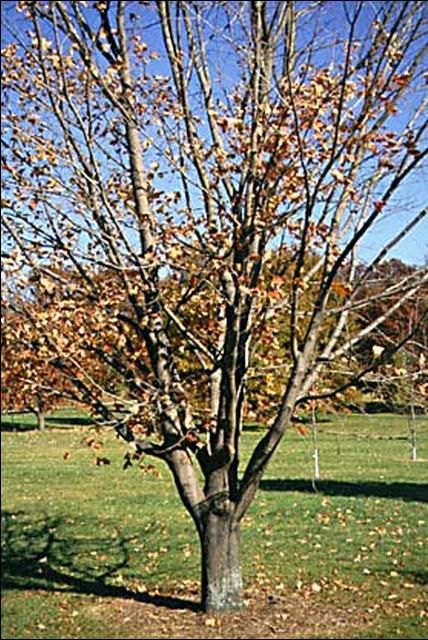
Strategies
- Establish and maintain a dominant leader by subordinating all but one codominant stem.
- Space main scaffold limbs apart by removing or shortening nearby branches.
- Anticipate future form and function by training and pruning early to avoid cutting large branches later; don't remove large branches because this initiates decay in the trunk. Shorten low branches before they grow so large they have to be removed.
- Position the lowest main scaffold limb high enough that it will not droop and have to be removed later.
- Prevent all branches from growing larger than half the trunk diameter.
- Maintain a live crown ratio of greater than 60%.
Putting the Plan Into Action
Begin pruning at planting and continue for 25 years. This strategy will provide a good branch and trunk structure.
At Planting
- All branches will eventually be removed on trees less than 4 inches caliper.
- Do not remove more than 25% of live foliage.
- Shorten or remove all leaders and branches competing with the one stem that would make the best leader.
- Remove broken, cracked or severely damaged branches.
Two Years
- All branches will eventually be removed on trees less than 4 inches caliper.
- Do not remove more than 40% of live foliage.
- Shorten or remove all competing leaders (you may have to do this in two stages if there are more than 3 leaders).
- Shorten or remove large, low, vigorous branches to improve clearance.
- Shorten or remove branches within 12 inches of largest diameter branches in the top halves of trees greater than about 4 inches caliper.
Four Years
- Most branches are still temporary and will eventually be removed from the tree.
- Do not remove more than 35% of live foliage.
- Shorten or remove competing leaders.
- Shorten or remove large, low, vigorous branches to improve clearance.
- Shorten or remove branches within 12 inches of largest diameter branches in top half of tree.
- There should be only one large branch per node (no clustered branches) so choose the best one and shorten branches that are nearby.
Eight Years
- Shorten or remove competing leaders.
- Do not remove more than 25 to 35% of foliage.
- Determine where you want the lowest permanent scaffold limb and shorten any aggressive branches lower than this limb.
- Shorten branches within 12 to 18 inches of largest diameter branches. There should be only one large branch per node (no clustered branches).
- Shorten low branches that will have to be removed later so that they do not become large.
Fourteen Years
- Shorten or remove competing leaders.
- Identify several permanent scaffold limbs.
- Shorten vigorous branches within 18 to 36 inches of permanent scaffold limbs.
- Shorten or remove large branches that grow lower on the trunk than the first permanent limb.
- There should be only one large branch per node (no clustered branches).
- Shorten low, vigorous branches that will have to be removed later.
Twenty Years
- Shorten or remove competing leaders.
- Identify 5 to 10 permanent scaffold limbs.
- Shorten vigorous branches within 18 to 36 inches of permanent scaffold limbs.
- Shorten or remove large branches that grow lower on the trunk than the first permanent limb.
- There should be only one large branch per node (no clustered branches).
- Shorten low, vigorous branches that will have to be removed later.
Twenty-Five Years
- Shorten or remove competing leaders.
- Continue to develop and space permanent scaffold limbs.
- Shorten branches within 36 inches of permanent scaffold limbs.
- Shorten or remove large branches that grow lower on the trunk than the first permanent branch.
- There should be only one large branch per node (no clustered branches).
- Shorten low branches that will have to be removed later.
Conclusion
With seven prunings in the first 25 years after planting, a good structure can be developed that can place the tree on the road to becoming a permanent fixture in the landscape. Less frequent pruning may be needed if you take care to plant good quality nursery trees with dominant leaders, and if you irrigate trees appropriately until they are established.